Find your way to a sense of purpose
 Ever wanted to live resolutely? Felt the need to be aware of where and why are you going and what are your intentions?
Ever wanted to live resolutely? Felt the need to be aware of where and why are you going and what are your intentions?
Dreams that foster a sense of purpose can potentially change the trajectory of an individual’s life. Finding meaning in life is one of the fundamental human needs. But for most people, finding a purpose is not apparent. The modern world tends to distract people from their actual goals and let them be pretentious about something which is not.
Our deepest fear is not that we are inadequate but powerful beyond measure. We are unaware of how to hold and direct our own light that it tends to frighten us more than our darkness. The secret to the meaning of life lies in recognising the true goals and aligning everything in life around that.
The Department of Entrepreneurship and Innovation is conducting a 45-minute workshop on How to fix progressive goals in life to give a glimpse of how powerful a simple act of discovering your purpose of life could be. This will be a demo session and is open to all. Post that, only 10 students will be taken for a coaching of 30 days impact programme, where mentors will be closely working with the ten individuals to create the change and become instrumental in the expected transformation. Students will be filtered for the 30 days impact programme through interviews and one-to-one interaction.
Date: July 27, 2022
Time: 7 pm to 8 pm IST
Join the session to pave your way to a sense of purpose.
- Published in Events, IDEA Events, Workshop
Colonial Impact on Pastoral Nomads and Caravan Traders in India
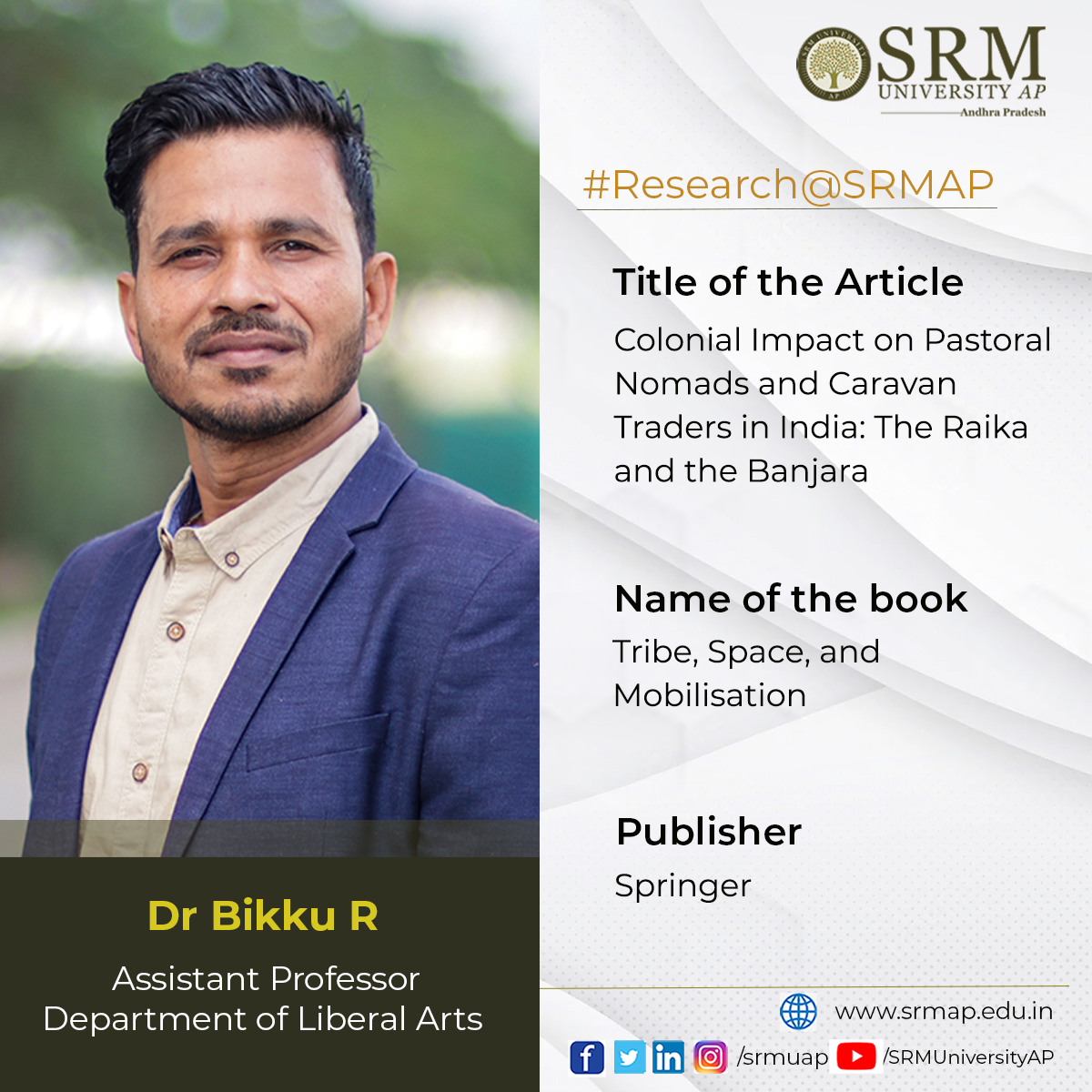 Cultural and Post-colonial studies enclose various historical approaches. It ranges from cultural studies and comparative social history to analysis of the means of domination and resistance. Nevertheless, there are communities that didn’t get the space they deserve in the studies of settled communities. Assistant Professor Dr Bikku R from the Department of Liberal Arts published a paper titled Colonial Impact on Pastoral Nomads and Caravan Traders in India: The Raika and the Banjara to analyse the aftereffects of colonialism in the most unexplored communities. The article was published in the book Tribe, Space, and Mobilisation.
Cultural and Post-colonial studies enclose various historical approaches. It ranges from cultural studies and comparative social history to analysis of the means of domination and resistance. Nevertheless, there are communities that didn’t get the space they deserve in the studies of settled communities. Assistant Professor Dr Bikku R from the Department of Liberal Arts published a paper titled Colonial Impact on Pastoral Nomads and Caravan Traders in India: The Raika and the Banjara to analyse the aftereffects of colonialism in the most unexplored communities. The article was published in the book Tribe, Space, and Mobilisation.
Abstract
The Raika of Rajasthan and the Banjara or Lambadi tribe of the Deccan region had been self-sustained as nomadic pastoralists and caravan traders, respectively, in pre-British India. Colonial policies imposed several restrictions on nomadic communities and their economic activities by branding them as ‘criminals’ under the Criminal Tribes Act of 1871. As a result, many of the nomadic communities lost their cultural economy and struggled to survive. Colonial and post-colonial studies have primarily focused on settled communities. However, little attention is paid to pastoral nomads and itinerary communities. The present paper focuses on the transformation of traditional nomadic livelihoods, culture, and economy of the two communities; the Raika pastoralist and the Banjara traditional caravan traders and livestock breeders’ as a consequence of colonial policies. It also emphasises current livelihood strategies. Empirical data resulting from ethnographic fieldwork and colonial and post-colonial literature have been examined. An ethnographic study among the Banjaras from the Deccan region during the year 2009- 2010 and the Raika of Rajasthan between 2013- 2015 and 2019 helped to understand their past and present situations. Colonial and post-colonial policies, governance, and their impact on pastoralists and other nomadic communities have been critically examined.
- Published in Departmental News, Liberal Arts News, News, Research News
Item feature refinement for improved content-based recommendation
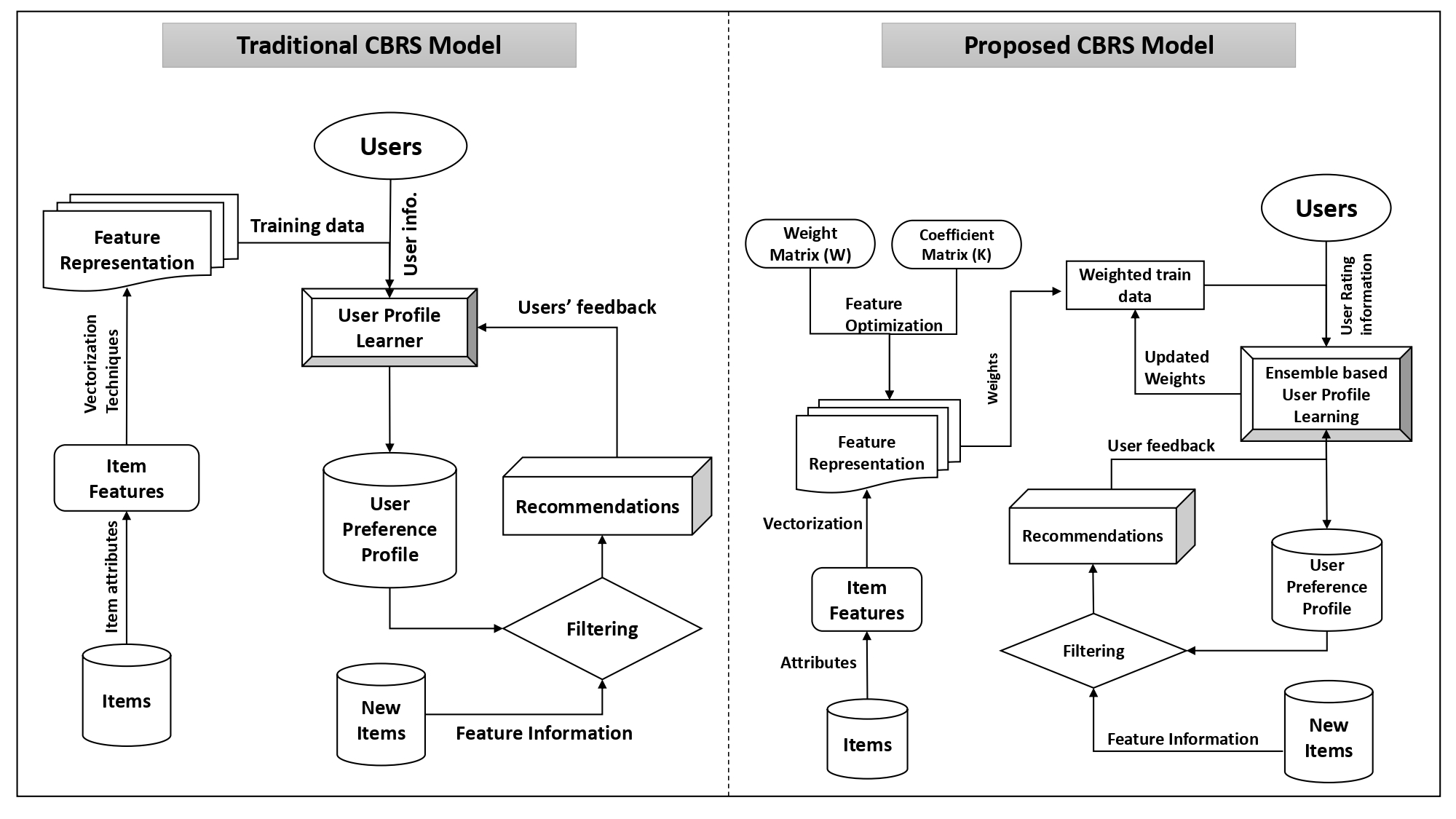
The Department of Computer Science and Engineering is delighted to announce that Dr Abinash Pujahari, Assistant Professor, has published his research article “Item Feature Refinement using Matrix Factorization and Boosted Learning based User Profile Generation for Content-Based Recommender Systems” in the journal Expert Systems with Applications having an Impact Factor of 8.665. The research was done in collaboration with Dr Dilip Singh Sisodia, Assistant Professor, National Institute of Technology Raipur.
This research focuses on improving the quality of information available about the features of various items so that it can be used for content-based recommendations. Content-based recommender systems are used in many e-commerce platforms (e.g., NetFlix, Amazon Prime, etc.). Here, the item (i.e., movies, TV shows) feature information is compared with the users’ past behaviour to recommend similar things. This research enables such systems to study the feature information for more accurate recommendations.
Most of the items’ feature information is sparse, redundant, and inconsistent. Matrix Factorization is used to avoid such inconsistencies. Further, iterative learning of user profiles is used using boosted learning approach for model building. The proposed research is compared with state-of-the-art related works using benchmark datasets and can be implemented in most e-commerce platforms and online streaming service providers. Dr Pujahari looks forwards to employing the same in group recommender systems where individuals have their preferences, in his future research endeavours.
- Published in CSE NEWS, Departmental News, News, Research News
Dr Manjesh Kumar
- Published in Assistant Professor, Faculty, ME Faculty, SEAS
Dr Ipsita Pradhan selected for a seminar on Urban Ethnography and Theory in Italy
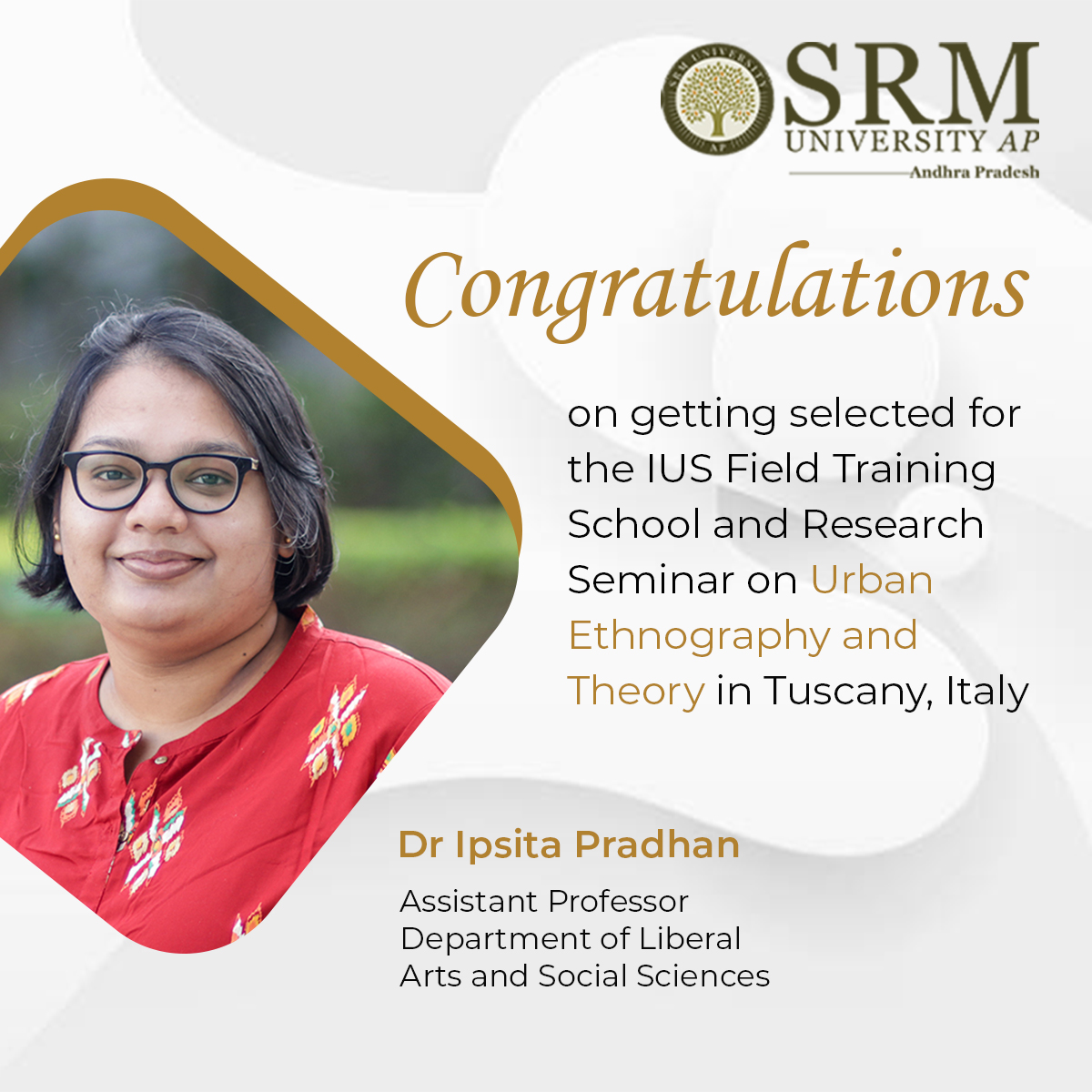 Recently, Assistant Professor Dr Ipsita Pradhan from the Department of Liberal Arts has been selected for the IUS Field Training School and Research Seminar on Urban Ethnography and Theory in Tuscany, Italy. The seminar was held from July 18 to 26, 2022.
Recently, Assistant Professor Dr Ipsita Pradhan from the Department of Liberal Arts has been selected for the IUS Field Training School and Research Seminar on Urban Ethnography and Theory in Tuscany, Italy. The seminar was held from July 18 to 26, 2022.
This eight-day Field Training School and Research Seminar is addressed to researchers, who are interested in ethnographic research and empirically grounded analysis. It is organised and hosted by the International Urban Symposium-IUS in collaboration with an international group of senior scholars from European, Indian, Middle Eastern, and US Universities. The school offers an interactive learning environment and opportunities to discuss the rationale and practices of research methods and mainstream debates. Participants will have the opportunity to present their own research and receive feedback from leading scholars. The Teaching Seminars will focus on methodological and theoretical debates, benefiting from senior scholars’ wide range of ethnographic, methodological, and theoretical expertise.
- Published in Departmental News, Liberal Arts News, News
Dual-Band 2×2 Elements MIMO Antenna-Diplexer
Dr Divya Chaturvedi, Assistant Professor, from the Department of Electronics and Communication Engineering has been keenly pursuing research on wearable antennas that are used within the context of Wireless Body Area Networks. These antennas are commonly used in wearable wireless communication and bio-medical RF systems. Her latest publication “Design and Investigation of Dual-Band 2×2 Elements MIMO Antenna-Diplexer Based on Half-mode SIW” was featured in the Q1 journal, IEEE Access, having an Impact Factor of 3.37. The research was done in collaboration with Assistant Professor Dr Goutam Rana and Research Scholar Ms Buela Pramodini from the Department of Electronics and Communication Engineering.
This antenna is designed to enhance data rate twice as much as a single antenna. The antenna can be used to operate in two frequency bands simultaneously, without causing any interference. One frequency band can be used for the transmission of data while the other frequency band can be utilised for the reception of data. The radiating elements are configured in such a way that it occupies a compact size. Thus, the designed antenna can be easily mounted or integrated into a portable wireless electronic device. The field from one radiating element is not coupled to the other element due to their adequate isolation that mitigates the interference problem.
The dual-band self-diplexing 4-port MIMO antenna operates in the lower frequency band around 3.4 GHz (3.35-3.55 GHz, 160 MHz) for the TD-LTE system and in the higher frequency band around 4.2 GHz (4.14-4.34 GHz, 200 MHz) for FCC ID WLAN in 5G LTE communication. The electronic devices which operate in these frequency bands can enhance the data transmission and reception speed twice as much as a single element. In other words, the proposed design prototype also improves the reliability of communication by employing the spatial multiplexing technique. In future, they plan to work on the design and investigation of MIMO-based self-diplexing antenna using the polarization diversity technique.
Abstract of the Research
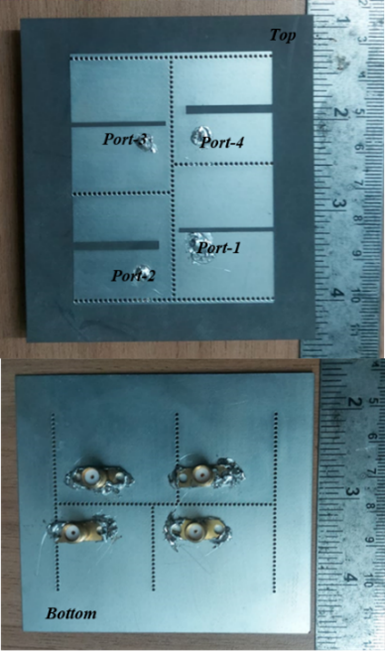
In this article, a compact dual-band, 2-elements antenna-diplexer is investigated and extended to a 2×2 multi-input and multi-output (MIMO) antenna. The proposed design employs half-mode Substrate Integrated Waveguide (HMSIW) technology, which reduces the antenna footprint by 50%. To enhance the bandwidth, a rectangular slot is engraved at the center of each HMSIW cavity. The slot splits the dominant mode of the HM cavity into two odd- and even-half TE110 modes in proximity, which leads to enhancement in the bandwidth by 50%. The antenna resonates around 3.4 GHz with a fractional bandwidth of 5% and around 4.3 GHz with a bandwidth of 4.7%, when corresponding ports are excited, respectively. Both the lower and upper frequency bands can be tuned individually, by simply altering the dimensions of each HMSIW cavity. This can be achieved in a common antenna, without employing filters, which satisfies the antenna-diplexer function. The isolation levels between any two radiating elements are obtained below -23 dB for the proposed MIMO antenna, and it occupies an overall size of 1.0λg × 0.8λg. The peak gain of the antenna is obtained at 5.35 dBi in the lower frequency band and at 6.75 dBi in the upper frequency band while radiation efficiency is better than 80% in both frequency bands.
- Published in Departmental News, ECE NEWS, News, Research News
Gendered work and contemporary India
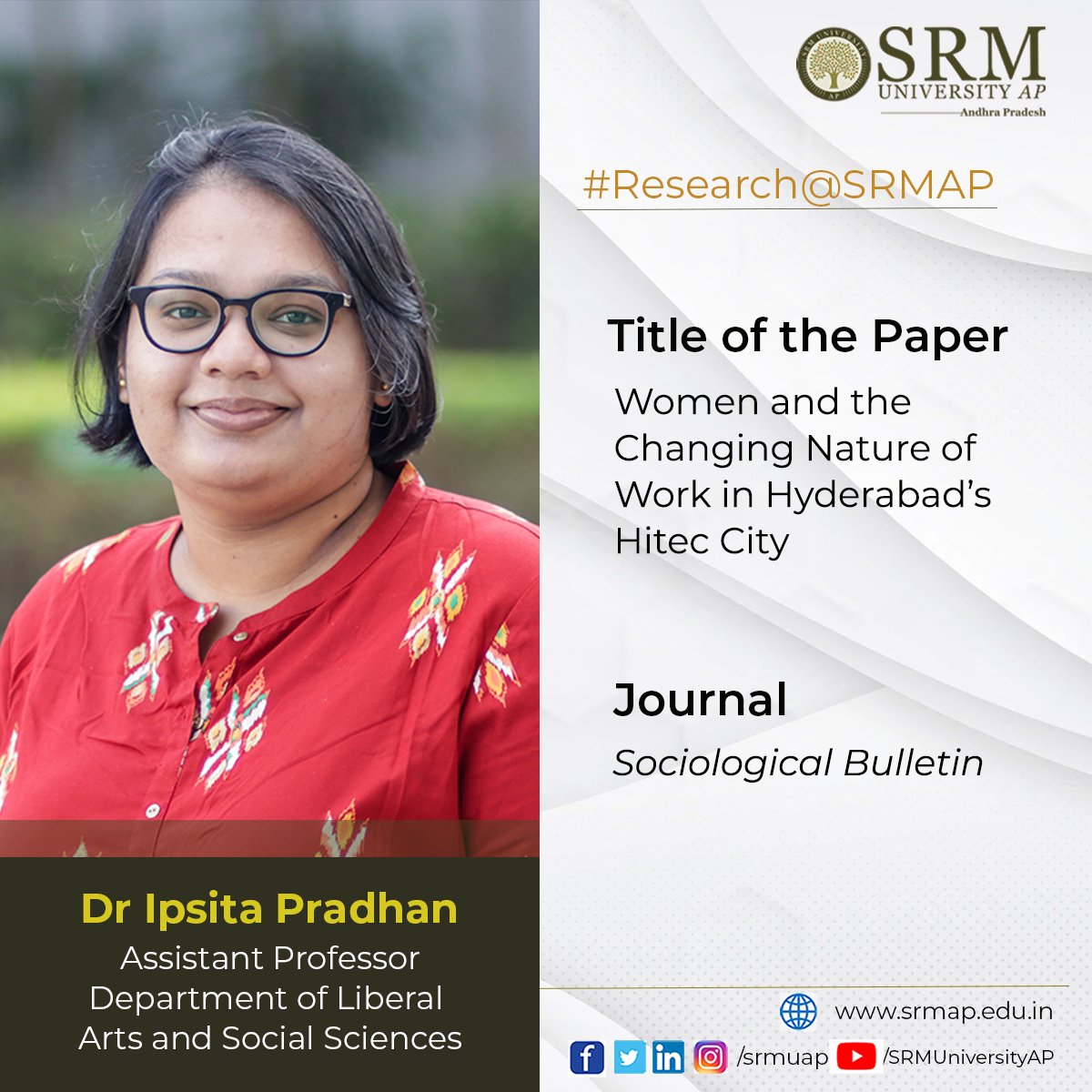 Economic institutions, technological developments, cultural norms, religious and intellectual currents, and popular beliefs have always played a huge role in asserting clear boundaries between men’s and women’s work. The recent research paper of Assistant Professor Dr Ipsita Pradhan, Department of Liberal Arts, focuses on the transformation of gendered work in contemporary India. The paper is titled Women and the Changing Nature of Work in Hyderabad’s Hitec City and was published in the journal Sociological Bulletin.
Economic institutions, technological developments, cultural norms, religious and intellectual currents, and popular beliefs have always played a huge role in asserting clear boundaries between men’s and women’s work. The recent research paper of Assistant Professor Dr Ipsita Pradhan, Department of Liberal Arts, focuses on the transformation of gendered work in contemporary India. The paper is titled Women and the Changing Nature of Work in Hyderabad’s Hitec City and was published in the journal Sociological Bulletin.
Abstract
This article looks at the ways in which gendered work is being transformed in contemporary India by focussing on Hyderabad, the capital of Telangana. Since the mid-1990s, after India opened its doors to multinational agencies, new forms of gendered labour have manifested. One of the ramifications of this gendered process is the feminisation of labour that enabled the participation of more women in the workforce, engaging in activities that were low-paid. The basis of feminisation is that certain jobs require fewer skills or particular kinds of skills, for which women are thought to be suitable. This also has implications for the low bargaining power of women workers. The feminisation of the labour force in HITEC city, Hyderabad is a consequence of the changing labour markets with globalisation, offshore factories, migration, and other changes in the workplace.
- Published in Departmental News, Liberal Arts News, News, Research News
SRM-AP organised a workshop on “Interactive Learning”

SRM University-AP organised a workshop on “Interactive Learning” to acquaint faculty with the evolving dynamics of teaching and learning, and the state-of-the-art pedagogical approaches. The two-day workshop was held on July 21 & 27, 2022 under the auspices of Prof Ranjit Thapa, Associate Dean in charge (Sciences), School of Engineering and Sciences. Faculty members from different schools attended the sessions and exchanged views on alternative methodologies to unravel the different facets of learning.
Prof T Raghunathan, Associate Dean in charge (Engineering), School of Engineering and Sciences, addressed the gathering and expounded his ideas on teaching. “Teaching encompasses the features of arts and science necessitating a teacher to don the roles of an artist and scientist”, he stated. It is the ‘how’ and ‘why’ of learning that a teacher should shed light on, according to Prof Raghunathan, to awaken students to their passion and lead a life of purpose.
Prof B V Babu, Dean- School of Engineering and Sciences, interacted with the faculty and spoke on the responsibility of a teacher in a university. He specified the diverse opportunities the university provides to its student community, such as research, placements, and entrepreneurship, and how teachers can contribute to enhancing the performance of students in different arenas. Unlike the conventional understanding, today’s teachers are bound to perform multiple roles to fulfil their obligation.
The session was presided over by Dr Karthik Rajendran, Assistant Professor and Faculty Coordinator, Department of Environmental Science. He rendered an engaging talk on active learning, encouraging the teachers to take up an amicable approach in classrooms and skilfully guide students through the learning process. Flipped classes, project-based learning, and peer learning are some of the interesting techniques that teachers can put to practice.
Dr Satya Pramod Jammy, Assistant Professor, Department of Mechanical Engineering, presented a session on different types of assessments that can be carried out to test the understanding of the students. He further elucidated the goals of assessment and how it should be aligned with meeting the practical requirements of the course rather than making students reproduce the content. He listed out the various assessment patterns followed at SRM-AP to ensure the learning caters to the all-round development of the student.
In the latter half of the workshop, Dr V M Manikandan, Assistant Professor, Department of Computer Science and Engineering, delivered a talk on the learning management system used at the university, its features and clarified doubts on how the application can be availed to make teaching and learning a full-fledged activity. Dr Balaguruprasad Narayanan, Associate Professor from the Department of Teaching and Learning Centre wrapped up the workshop with an extended session on outcome-based learning.
The genealogy of post-truth and fake news in the Indian context
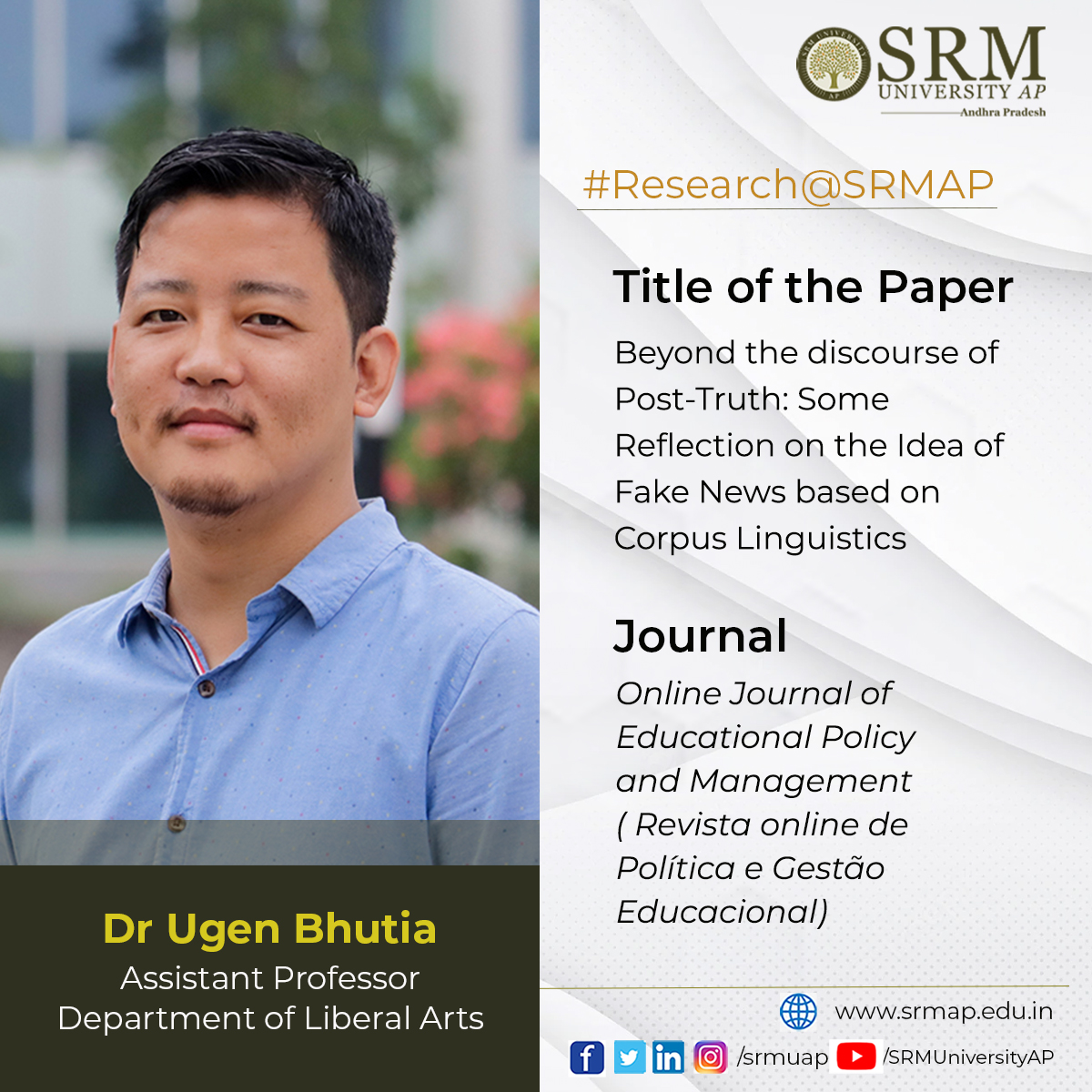 Post-truth represents the replacement of facts with personal beliefs and emotional appeals in order to shape public opinion. The distinction between fake and real news is not about reliable and unreliable sources. It’s about honesty and deception. The media can both inform and deceive people. What makes the news fake is the intention of its author. Discourses are produced by the effects of power within a social order. This power prescribes certain rules and categories that define the criteria for legitimating knowledge and truth within the discursive order. Assistant Professor Dr Ugen Bhutia of the Department of Liberal Arts published an article titled Beyond the discourse of Post-Truth: Some Reflection on the Idea of Fake News based on Corpus Linguistics in the Online Journal of Educational Policy and Management.
Post-truth represents the replacement of facts with personal beliefs and emotional appeals in order to shape public opinion. The distinction between fake and real news is not about reliable and unreliable sources. It’s about honesty and deception. The media can both inform and deceive people. What makes the news fake is the intention of its author. Discourses are produced by the effects of power within a social order. This power prescribes certain rules and categories that define the criteria for legitimating knowledge and truth within the discursive order. Assistant Professor Dr Ugen Bhutia of the Department of Liberal Arts published an article titled Beyond the discourse of Post-Truth: Some Reflection on the Idea of Fake News based on Corpus Linguistics in the Online Journal of Educational Policy and Management.
Abstract
The article illustrates how we deceive ourselves by attempting to understand fake news through the notion of a post-truth society. The paper argues that the concepts of fake news and post-truth are not an aberration in the history of media practices and neither of contemporary origins. They are an intricate part of the discursive practices in which media as an institution engages. The article builds on Foucault’s approach to discursive practices and applies a meta-discursive framework to trace the genealogy of post-truth and fake news in an Indian context. The article also critically reflects on some key strategies to contain and counter fake news. For instance, media literacy and linguistic approaches such as corpus linguistics to detect fake news.
- Published in Departmental News, Liberal Arts News, News, Research News
Watermarking medical images for their secure transmission

The Department of Computer Science and Engineering is proud to announce that Dr Priyanka, Assistant Professor, and her research Scholar, Ms Kilari Jyothsna Devi have published their patent (application no: 202241033779 A), “A System and a Method for Watermarking Medical Images for the Secure Transmission of Images”. The patent was published on June 17, 2022, by the Indian Patent Office.
In the present technology, medical images and patient information are widely transmitted through a public transmission channel in e-healthcare applications. While sharing medical images or electronic patient records (EPR) through a public network, they can get tampered with or manipulated, leading to wrong diagnosis by the medical consultants. Similarly, one can easily claim false ownership of the medical images. This makes the confidentiality of the patient record at low cost a major concern.
The proposed novel MIW scheme ensures most of the watermarking characteristics such as high imperceptibility, robustness, security with low computational cost, temper detection and recovery in medical image transmission in real-time healthcare applications. In the future, they intend to design digital image watermarking schemes for the secure transmission of images over blockchain and cloud-based applications.
- Published in CSE NEWS, Departmental News, News, Research News

